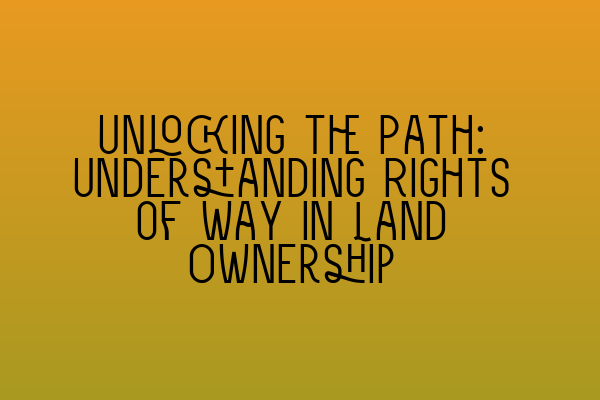Unlocking the Path: Understanding Rights of Way in Land Ownership
Welcome to another informative blog post from SQE Property Law & Land Law! Today, we will be delving into the fascinating subject of rights of way in land ownership. This often overlooked aspect of property law can have a significant impact on your property rights and can sometimes even lead to conflicts and legal disputes. Therefore, it is crucial to have a good understanding of rights of way to navigate the complexities of land ownership successfully.
So, let’s begin by answering the fundamental question: What exactly is a right of way? In simple terms, a right of way is a legal easement that allows someone to pass through another person’s property. It can be either public or private, granting access to roads, footpaths, or other thoroughfares. These rights can be explicitly granted in the property’s deeds or established through long-standing usage.
Now, you might be wondering what the different types of rights of way are and how they affect land ownership. Allow us to enlighten you. There are two primary types of rights of way: public and private.
Public rights of way are typically established by law and are open to the general public. These can include public roads, bridleways, and footpaths. Local authorities are responsible for maintaining and enforcing these rights, ensuring that the public can enjoy access to certain areas, such as parks, forests, or even coastlines.
On the other hand, private rights of way are specific to individual landowners and their neighbors. These rights are often defined and protected by legal documents, such as easement agreements or deeds. Private rights of way can grant access to neighboring properties, businesses, or amenities, providing convenience and facilitating daily activities.
However, it’s important to note that not all rights of way are created equal. Some may be limited to certain times of the day, specific purposes, or a designated number of users. To fully understand the scope and limitations of your right of way, it’s crucial to review the legal documents associated with your property or seek professional legal advice.
Now that we’ve covered the basics let’s explore some common situations where rights of way come into play. One common scenario is when landowners need to access their property through someone else’s land. In such cases, a right of way ensures that landowners can enter their properties without infringing upon their neighbor’s rightful ownership.
Another situation arises when there is a dispute regarding the right of way. Conflicts can occur when there is uncertainty about the location, extent, or nature of the right of way. Disputes can also arise when a landowner tries to obstruct or deny access to a documented right of way. Resolving these conflicts often requires legal intervention to ensure fair and just outcomes for all parties involved.
To avoid potential conflicts and disputes, it is advisable to thoroughly investigate and understand any rights of way associated with a property before purchasing or developing it. This will help you make informed decisions and clarify any potential issues, ensuring a smooth and hassle-free experience.
At SQE Property Law & Land Law, we understand the complexities surrounding rights of way and the impact they can have on land ownership. Our team of experienced solicitors is well-versed in all aspects of property law and can provide you with expert guidance to navigate the intricacies of rights of way.
If you’re interested in further expanding your knowledge of property law, we invite you to explore our related articles:
– SQE 1 Practice Exam Questions
– SQE 1 Practice Mocks FLK1 FLK2
– SQE 2 Preparation Courses
– SQE 1 Preparation Courses
– SRA SQE Exam Dates
These articles provide valuable insights and resources to assist you in your knowledge journey.
In conclusion, understanding rights of way is essential for both landowners and potential buyers. Whether it’s a public right of way or a private one, having a clear understanding of your rights and responsibilities is crucial to avoid conflicts and legal issues. Should you require expert legal advice or assistance with any property-related matter, don’t hesitate to reach out to SQE Property Law & Land Law. Our team is here to guide you and provide the utmost professional and personalized service.
Remember, knowledge is power, and unlocking the path to understanding rights of way in land ownership is a critical step toward successful property management.
